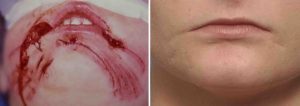Background: Dog bite injuries to the face in children are often more common than in adults. The small size of the infant and child put their face at a level that is closer to a dog than that of adult. This combined with their natural lack of fear of dogs nor an understanding of how they may behave in certain circumstances put them at risk for such injuries.
Having repaired many facial dog bite injuries in children as well as having written on the topic, what is clear is that the vast majority of them will need to undergo subsequent scar revisions. The only question is how many scar revisions will be needed and what the long-term scar outcomes will be.


For the child who has sustained a severe facial soft tissue injury, the extent of the tissue damage can be devastating and the prognosis for a normal appearance grim. But with good surgical technique of soft tissue repair and subsequent scar revision, the outcome can be far better than one could anticipate when viewing the original injury. Hopefully this case will provide some optimism to those young children and their parents who have been so affected.
Highlights:
1) Dogbites in infants and children often involve the face around the mouth and lips areas.
2) Primary and secondary repairs of the orofacial dogbite injury, while never completely restoring the tissues to normal, can create very acceptable long-term appearances.
3) The need for scar revisions of a facial dog bite injury are common and the only question is how many such revisions will be needed.
Dr. Barry Eppley
Indianapolis, Indiana


